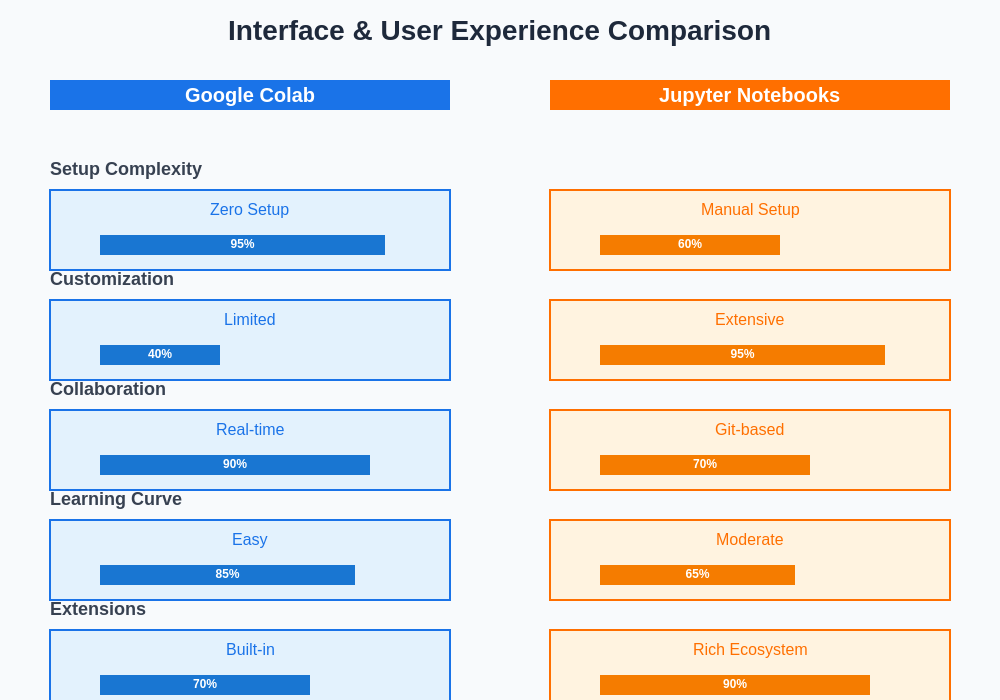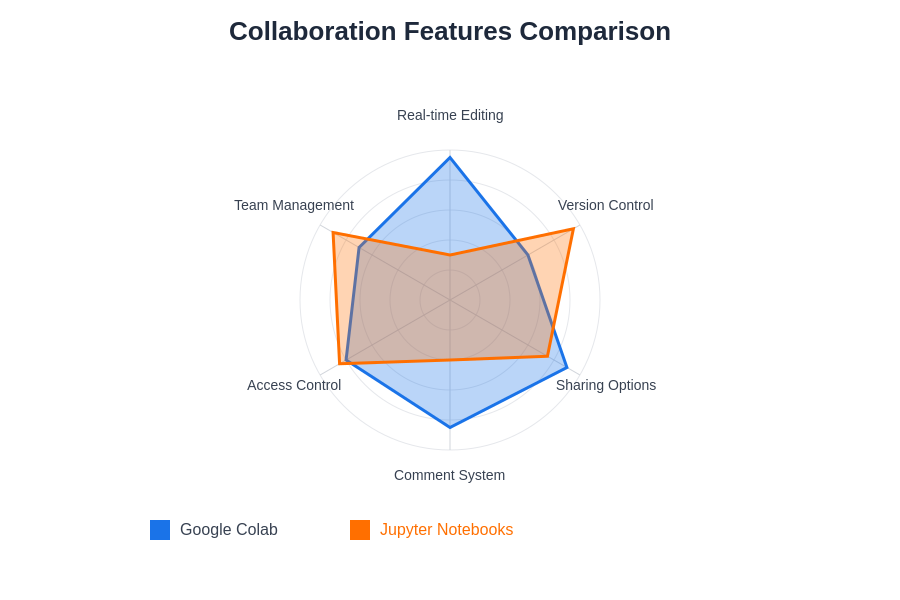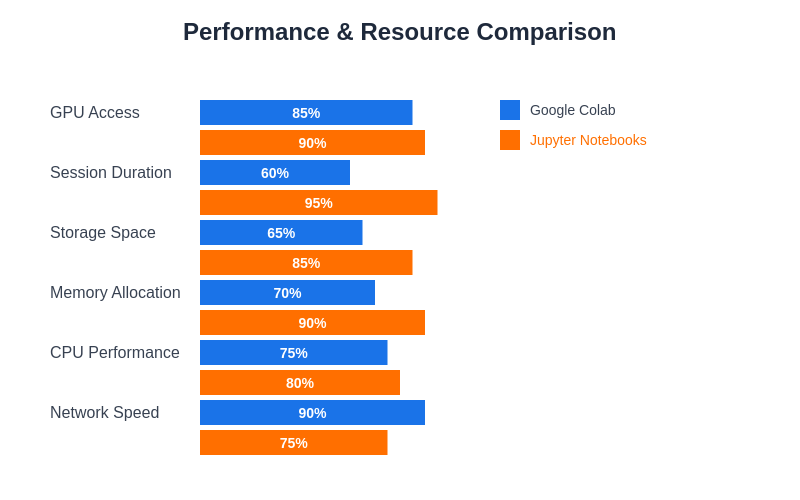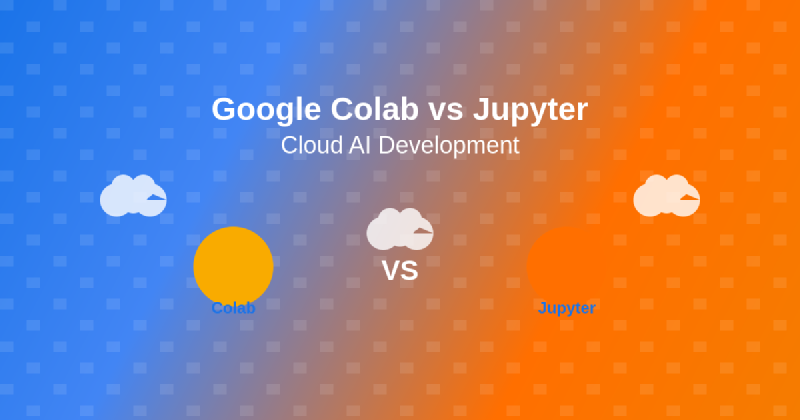The evolution of artificial intelligence and machine learning development has been significantly influenced by the availability of powerful, accessible development environments that enable researchers, data scientists, and developers to experiment, prototype, and deploy sophisticated models without the constraints of local hardware limitations. Two platforms have emerged as dominant forces in this landscape: Google Colab and Jupyter Notebooks, each offering distinct advantages and serving different aspects of the AI development ecosystem.
Explore the latest AI development trends to understand how cloud-based development environments are shaping the future of machine learning and artificial intelligence research. The choice between these platforms often determines the trajectory of projects, influencing everything from initial experimentation to final deployment strategies.
Understanding the Fundamentals
Google Colab, officially known as Google Colaboratory, represents Google’s ambitious entry into the cloud-based notebook computing space, offering free access to powerful computing resources including GPUs and TPUs directly through a web browser. This platform has democratized access to high-performance computing resources that were previously available only to organizations with substantial infrastructure budgets or individuals with expensive hardware setups.
Jupyter Notebooks, on the other hand, originated as an open-source project that transformed how interactive computing is approached across multiple programming languages. While traditionally requiring local installation and configuration, Jupyter has evolved to support various deployment models, including cloud-based solutions that compete directly with proprietary offerings like Google Colab. The platform’s flexibility and extensibility have made it the foundation for numerous specialized data science and machine learning workflows.
The fundamental difference between these platforms lies in their architectural approach and target use cases. Google Colab prioritizes simplicity and immediate accessibility, providing a ready-to-use environment with pre-installed libraries and seamless integration with Google’s ecosystem of services. Jupyter Notebooks emphasize flexibility and customization, allowing users to create highly specialized environments tailored to specific project requirements and organizational needs.
Performance and Computational Resources
The computational capabilities offered by each platform represent one of the most critical factors influencing platform selection for AI development projects. Google Colab provides free access to NVIDIA Tesla K80, T4, and P4 GPUs, along with Google’s custom Tensor Processing Units (TPUs), which are specifically optimized for machine learning workloads. These resources are allocated on a session basis, with usage limits that prevent individual users from monopolizing available hardware while ensuring reasonable access for educational and research purposes.
Experience advanced AI capabilities with Claude to supplement your development workflow with intelligent code assistance and architectural guidance. The integration of AI assistants with cloud development platforms creates a powerful synergy that accelerates project development and improves code quality.
The performance characteristics of Google Colab’s hardware allocation system introduce both opportunities and limitations that users must carefully consider. Sessions are subject to timeout restrictions, typically lasting 12 hours for free accounts, with the possibility of earlier termination if resources are needed elsewhere. This constraint requires developers to structure their workflows around these limitations, often necessitating frequent checkpointing and state preservation strategies to avoid losing computational progress.
Jupyter Notebooks deployed on cloud infrastructure or high-performance local machines can potentially offer superior computational consistency and control. Users can configure environments with specific hardware requirements, maintain persistent sessions across extended periods, and customize resource allocation based on project needs. However, this flexibility comes with increased complexity in setup, configuration, and ongoing maintenance that may not be suitable for all users or use cases.
The memory and storage capabilities of each platform also differ significantly. Google Colab provides limited disk space that is ephemeral by default, requiring integration with Google Drive or other cloud storage services for persistent data management. Jupyter deployments can be configured with virtually unlimited storage capacity, depending on the underlying infrastructure, but require careful planning and management to ensure data persistence and backup strategies.
Development Environment and User Experience
The user interface and development experience represent fundamental differentiators between Google Colab and Jupyter Notebooks that significantly impact productivity and user adoption. Google Colab offers a streamlined, browser-based interface that closely resembles Google Docs, making it immediately familiar to users already comfortable with Google’s productivity suite. This design philosophy prioritizes ease of use and reduces the learning curve for newcomers to notebook-based development.
The collaborative features integrated into Google Colab mirror those found in other Google Workspace applications, enabling real-time collaboration, commenting, and sharing capabilities that facilitate team-based development projects. Multiple users can simultaneously edit notebooks, leave comments on specific cells, and track changes through integrated version history, creating a development environment that supports modern collaborative workflows.
Jupyter Notebooks provide a more traditional notebook interface that emphasizes functionality and extensibility over visual polish. The interface can be heavily customized through themes, extensions, and custom CSS, allowing users to create development environments that precisely match their preferences and workflow requirements. This customization capability extends to keyboard shortcuts, cell execution behavior, and integration with external tools and services.

The extensibility of Jupyter through its rich ecosystem of extensions and plugins enables users to add sophisticated functionality such as variable inspectors, code formatting tools, table of contents generation, and integration with version control systems. This extensibility represents both an advantage and a potential source of complexity, as users must invest time in discovering, installing, and configuring extensions to achieve optimal productivity.
Library Management and Environment Setup
The approach to library management and environment configuration represents another critical distinction between these platforms that directly impacts development efficiency and project reproducibility. Google Colab comes pre-configured with an extensive collection of popular machine learning and data science libraries, including TensorFlow, PyTorch, scikit-learn, pandas, NumPy, and matplotlib. This pre-installation eliminates the common friction associated with dependency management and version conflicts that often plague local development environments.
The library management system in Google Colab supports dynamic installation of additional packages through pip and conda commands executed directly within notebook cells. While this approach offers flexibility for adding specialized libraries, it introduces challenges for environment reproducibility, as package versions may change between sessions and dependency conflicts can arise when multiple notebooks require different library versions.
Jupyter Notebooks deployed in controlled environments offer superior dependency management through containerization technologies like Docker, virtual environments, or conda environments. This approach enables precise control over library versions, reproducible environment setup, and isolation between different projects. However, achieving this level of control requires additional expertise in environment management and infrastructure configuration that may be beyond the scope of some users.
Discover comprehensive AI research capabilities with Perplexity to enhance your development workflow with advanced information gathering and analysis tools. The integration of research and development platforms creates a seamless workflow from initial concept exploration to implementation and testing.
The package installation speed and reliability also differ between platforms. Google Colab benefits from pre-cached popular packages and high-bandwidth connections that enable rapid installation of additional dependencies. However, the ephemeral nature of Colab sessions means that custom installations must be repeated for each new session, potentially impacting productivity for workflows that require specialized or less common libraries.
Data Management and Storage Integration
Data management capabilities represent a crucial consideration for AI development projects, where datasets can range from small experimental files to massive training corpora requiring sophisticated storage and access strategies. Google Colab integrates seamlessly with Google Drive, enabling users to mount their Drive storage directly within notebook sessions and access files using familiar file system operations. This integration provides a convenient solution for small to medium-sized datasets and ensures data persistence across sessions.
The Google Drive integration also supports collaborative data sharing, allowing team members to access shared datasets and results without complex file transfer procedures. However, the performance characteristics of Google Drive access may not be optimal for large datasets or intensive I/O operations, potentially creating bottlenecks in data processing workflows.
Google Colab also provides integration with Google Cloud Storage, BigQuery, and other Google Cloud Platform services, enabling access to enterprise-scale data management solutions. These integrations require additional configuration and may incur costs, but they provide the scalability and performance characteristics necessary for production-scale AI development projects.
Jupyter Notebooks offer more flexible data management options, supporting integration with virtually any storage system or database through appropriate Python libraries and connectors. This flexibility enables connections to local file systems, network-attached storage, cloud storage services from multiple providers, and specialized data management platforms optimized for machine learning workloads.
Collaboration and Sharing Capabilities
The collaborative development features of each platform significantly influence their suitability for team-based projects and educational environments. Google Colab excels in collaborative scenarios through its real-time editing capabilities, integrated commenting system, and seamless sharing mechanisms that mirror other Google Workspace applications. Multiple users can simultaneously edit notebooks, with changes synchronized in real-time and conflict resolution handled automatically.
The sharing capabilities of Google Colab extend beyond simple file sharing to include fine-grained permission control, allowing notebook owners to specify whether collaborators can view, comment, or edit shared notebooks. This granular control enables flexible collaboration models that can accommodate different team structures and project requirements.

The version history system in Google Colab provides automatic tracking of changes with the ability to revert to previous versions, though this system is less sophisticated than dedicated version control systems like Git. For projects requiring formal version control procedures, Google Colab can be integrated with GitHub and other Git-based platforms, though this integration requires additional setup and workflow considerations.
Jupyter Notebooks traditionally rely on external version control systems for collaboration, typically Git-based platforms like GitHub, GitLab, or Bitbucket. While this approach provides more sophisticated version control capabilities, it requires team members to be familiar with Git workflows and may create barriers for non-technical collaborators.
Cost Considerations and Resource Limitations
The economic factors associated with each platform play a crucial role in platform selection, particularly for educational institutions, startups, and individual researchers operating with limited budgets. Google Colab offers a generous free tier that provides access to GPU and TPU resources without charge, making it an attractive option for learning, experimentation, and small-scale projects. However, the free tier includes usage limitations and resource restrictions that may impact productivity for intensive workloads.
Google Colab Pro and Pro+ subscriptions provide enhanced resource allocation, longer session durations, and priority access to premium GPUs for monthly fees that are competitive with cloud computing alternatives. These paid tiers address many of the limitations of the free service while maintaining the simplicity and ease of use that characterizes the platform.
The cost structure of Jupyter-based solutions varies significantly depending on the deployment model and underlying infrastructure. Local deployments require investment in hardware but avoid ongoing operational costs, while cloud-based Jupyter deployments incur charges based on compute time, storage usage, and data transfer. The total cost of ownership for Jupyter solutions can be lower or higher than Google Colab depending on usage patterns and resource requirements.
Security and Data Privacy Considerations
Data privacy and security considerations have become increasingly critical factors in platform selection, particularly for organizations handling sensitive data or operating in regulated industries. Google Colab processes all data within Google’s cloud infrastructure, which may raise concerns for organizations with strict data residency requirements or those handling confidential information that cannot be processed on third-party platforms.
The terms of service for Google Colab grant Google certain rights to access and analyze data processed on the platform, primarily for service improvement and abuse prevention purposes. While Google maintains strong security practices and compliance certifications, some organizations may be uncomfortable with this level of data exposure regardless of the technical safeguards in place.
Jupyter Notebooks deployed on private infrastructure or in private cloud environments can provide greater control over data security and privacy. Organizations can implement their own security policies, encryption standards, and access controls without relying on third-party data processing agreements. However, this control comes with increased responsibility for security management and compliance maintenance.
Performance Optimization and Scalability
The scalability characteristics of each platform influence their suitability for projects that may grow from experimental prototypes to production-scale implementations. Google Colab’s resource allocation system provides automatic scaling within predefined limits, but users have limited control over resource allocation and cannot easily scale beyond the platform’s constraints without migrating to different infrastructure.
The integration between Google Colab and other Google Cloud Platform services provides potential migration paths for projects that outgrow Colab’s limitations. Notebooks can be exported and deployed on Google Cloud AI Platform, Vertex AI, or custom Compute Engine instances, though this migration requires additional configuration and may involve changes to code and workflows.
Jupyter-based deployments can be architected from the beginning to support horizontal scaling through containerization, orchestration platforms like Kubernetes, and integration with cloud-native services. This architectural flexibility enables smooth scaling from single-user deployments to multi-user enterprise platforms without fundamental changes to the development workflow.
Integration with AI and ML Ecosystems
The ecosystem integration capabilities of each platform significantly impact their utility for comprehensive AI development workflows that span from data preparation through model deployment and monitoring. Google Colab provides native integration with TensorFlow, TensorBoard, and other Google-developed machine learning tools, creating a seamless experience for projects built on Google’s ML ecosystem.
The integration with Google Cloud Platform services enables Colab users to leverage enterprise-scale ML services such as AutoML, Vertex AI, and BigQuery ML directly from their notebooks. These integrations can significantly accelerate development workflows by providing access to pre-trained models, automated feature engineering, and managed training infrastructure.

The performance characteristics of each platform reveal distinct advantages depending on specific use case requirements. While Google Colab excels in providing immediate access to powerful hardware resources, Jupyter deployments offer greater control over resource allocation and session management for sustained development workflows.
Jupyter Notebooks support integration with virtually any Python-based ML framework or tool, providing flexibility to choose the most appropriate technologies for specific project requirements. This ecosystem neutrality enables users to combine tools from different vendors and open-source projects without platform restrictions.
Educational and Learning Applications
The educational applications of these platforms have significantly influenced their adoption in academic institutions and professional training programs. Google Colab’s zero-setup requirement and immediate access to powerful hardware make it particularly well-suited for educational environments where students may have limited technical expertise or access to high-performance computing resources.
The collaborative features of Google Colab facilitate classroom environments where instructors can share assignments, students can collaborate on projects, and peer review processes can be implemented without complex infrastructure requirements. The integration with Google Classroom and other educational platforms further enhances its utility in formal educational settings.
Jupyter Notebooks have been widely adopted in academic and research environments due to their flexibility, extensibility, and support for reproducible research practices. The ability to create self-contained computational narratives that combine code, results, and documentation makes Jupyter particularly valuable for research publications and educational materials that require transparency and reproducibility.
Future Development and Platform Evolution
The trajectory of development for both platforms indicates continued evolution and enhancement of capabilities that will influence their relative competitive positions. Google continues to invest in Colab development, regularly adding new features, improving performance, and expanding integration with other Google Cloud services. Recent additions include enhanced debugging capabilities, improved version control integration, and expanded hardware options.
The open-source nature of Jupyter ensures continued development through community contributions and commercial support from various organizations building products and services around the Jupyter ecosystem. This distributed development model provides resilience against changes in corporate priorities while enabling rapid innovation and adaptation to emerging requirements.
The convergence of cloud computing, artificial intelligence, and collaborative development tools suggests that both platforms will continue to evolve toward more sophisticated, integrated solutions that address the complete lifecycle of AI development projects. The competition between these approaches ultimately benefits users by driving innovation and improving the quality and accessibility of AI development tools.
Making the Right Choice for Your Projects
The selection between Google Colab and Jupyter Notebooks should be based on careful consideration of project requirements, team capabilities, budget constraints, and long-term strategic objectives. Google Colab represents an excellent choice for educational applications, rapid prototyping, individual research projects, and scenarios where immediate access to powerful hardware is more important than infrastructure control or customization capabilities.
Jupyter Notebooks are better suited for production-oriented projects, team environments with specific infrastructure requirements, organizations with strict data privacy requirements, and workflows that require extensive customization or integration with specialized tools and services. The additional complexity and setup requirements of Jupyter deployments are justified when control, flexibility, and scalability are primary concerns.
The ideal solution for many organizations may involve a hybrid approach that leverages the strengths of both platforms. Initial experimentation and prototyping can be conducted using Google Colab’s accessible environment, while production development and deployment utilize more controlled Jupyter-based infrastructure. This approach maximizes productivity while maintaining appropriate control over critical production systems.
Disclaimer
This article is for informational purposes only and does not constitute professional advice. The comparisons and recommendations presented are based on current platform capabilities and general use case scenarios. Readers should evaluate their specific requirements, conduct their own testing, and consider consulting with technical experts when making platform decisions for critical projects. Platform features, pricing, and capabilities may change over time, and readers should verify current information directly with platform providers.
